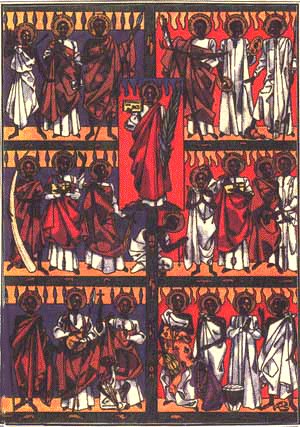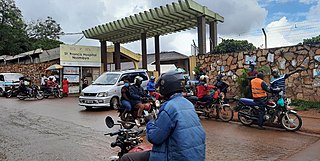
Achilleus Kiwanuka, also known as Achileo Kiwanuka or Achilles Kiwanuka or Achiles Kiwanuka, was a Ugandan Catholic martyr revered as a saint in the Catholic Church.

Emmanuel Kiwanuka Nsubuga was a Uganda Catholic prelate who served as the first Archbishop of Kampala from 1966 to 1990 and as a cardinal from 1976 until his death. He was an opponent of human rights abuses of the military dictatorship of Idi Amin.

The Archdiocese of Kampala is the Metropolitan See for the Roman Catholic Ecclesiastical province of Kampala in Uganda.
Namilyango College is a boys-only boarding secondary school located in Mukono District in the Central Region of Uganda, whose history and excellence in sports and academics have made it one of the most prestigious schools in Uganda. It is Uganda's oldest secondary school, founded in 1902 by the Catholic Mill Hill Fathers.

Centenary Bank, also Centenary Rural Development Bank Limited (CRDBL), is a commercial bank in Uganda licensed by the Bank of Uganda, the central bank and national banking regulator.

St. Francis Hospital Nsambya, commonly known as Nsambya Hospital, is a hospital in Kampala, the capital of Uganda and the largest city in that country.
Lubaga is a hill in Kampala, Uganda's capital and largest city. It comes from the Luganda word okubaga, describing a process of "planning" or "strengthening" a structure while constructing it. For example, okubaga ekisenge means to strengthen the internal structure of a wall while building a house. The name also applies to the neighborhood on the hill.
Movement House is a building under construction in Kampala, the capital of Uganda and the largest city in that country. The building is sometimes referred to as NRM House, in reference to its largest tenant, the National Resistance Movement (NRM), the ruling political party in Uganda since 1986.
Kisubi Mapeera Secondary School is a secondary school in Kampala, Uganda. The school gets its name from a tent peg which the missionary, Père Simon Lourdel M.Afr. turned into a tree. "Mapeera" is the Baganda rendition of "Mon Pere".

Cyprian Kizito Lwanga was a Ugandan Roman Catholic Prelate who served as Archbishop of Kampala from 2006 to his death. From 1996 to 2006, he served as Bishop of Kasana–Luweero.
The Mukono–Kyetume–Katosi–Nyenga Road is a road in the Central Region of Uganda, connecting the towns of Mukono, Kyetume and Katosi in Mukono District to Nkokonjeru and Nyenga in Buikwe District.

The Ministry of Health is a cabinet-level government ministry of Uganda. It is responsible for planning, delivering, and maintaining an efficient and effective healthcare delivery system, including preventive, curative, and rehabilitative services, in a humane, affordable, and sustainable manner. The ministry is headed by Minister of Health Jane Aceng.
Frederick Drandua was a Ugandan Roman Catholic priest, who served as the Bishop of the Roman Catholic Diocese of Arua, in Uganda, from 27 May 1986 until 19 August 2009.
Joseph Oyanga, was a Ugandan Roman Catholic priest who served as the Bishop of the Roman Catholic Diocese of Lira from 4 July 1989 until 2 December 2003.
Cesare Asili was a Ugandan Catholic priest who served as Bishop of the Roman Catholic Diocese of Lira. He was appointed bishop of Lira on 12 July 1968 and he died as such on 12 October 1988.
Thobani Centre is a commercial building in Kampala, the capital and largest city of Uganda.
Erasmus Desiderius Wandera was a Ugandan Catholic prelate who served as the Bishop of Soroti from 29 March 1981 until 27 June 2007.
The pioneer White Fathers were affiliated to the Catholic Missionary Society of White Fathers which is also known as Religious Institute of the Missionaries of Africa. They arrived in Algiers on February 1874. They started their journey to Equatorial Africa on 15th November 1878. They spent 10 months on their journey in which 2 months were spent in a boat from Algiers to Bagamoyo and the other 8 months on foot from Bagamoyo to Kigungu.









